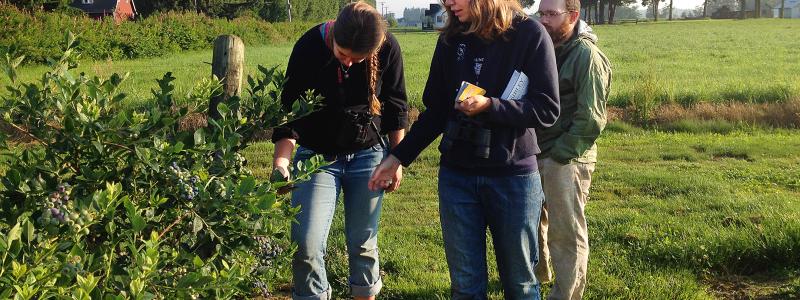TWU collaborates with Michigan State and Cornell on first-of-its-kind research study on pests in fruit crops.
As part of a $2 million Specialty Crop Research Initiative (SCRI) grant from the United States Department of Agriculture, Trinity Western University researchers are collaborating with researchers from Michigan State University and Cornell University on a first-of-its-kind study to assess and address bird damage to fruit crops in three major temperate zones across North America.
The study, which began in summer 2012, will follow four fruit crops—cherry, blueberry, Honeycrisp apples, and wine grapes—over a three-year period across the Pacific Northwest, Michigan State, and the Finger Lakes region of New York State.
Heading up the Pacific Northwest team is TWU’s Karen Steensma, M.Sc., Associate Professor of Biology, who has taught at TWU for 27 years. “What presents itself for research is sometimes found in your own back yard,” said Steensma, who is also a commercial dairy farmer in Washington State. “For example, salmon swim upstream and spawn on farmland—it’s that connection between natural systems and agriculture that makes this type of project intriguing.”
Steensma’s current research is an outgrowth of her earlier work on kestrel falcons, a predatory bird she is testing as a means to control the non-native starling populations that are decimating fruit crops across North America—including British Columbia and Washington State. “As biologists, we’re not coming at it as pest eradicators,” Steensma said, “but rather with an eye toward how we can improve the agro-ecosystem.”
TWU’s portion of the SCRI grant—$100,000 per year for three years—allows Steensma’s team of field researchers to collect data from May through November. Their findings will then be analyzed throughout the remainder of the year. “I really like being able to bring students into the field,” said Steensma, “to experience real-world problems.”
Armed with binoculars and led by TWU alumna Deanna Leigh (’07), the six-person field team—affectionately dubbed the “Bird People”—followed crops as they ripened around the region. “The season was hectic but rewarding,” said Leigh, “especially considering how variable crops can be. We worked in as many as 24 fields of a particular crop, sampling as close to harvest as possible. We were under a lot of pressure to get everything done—but our team worked really well together and we had a blast spending the long summer days, literally, out in the field.”
In their second year of study, the team hopes to test bird deterrent or control techniques, including falconry, which has yielded positive results but is costly. Other methods they plan to test include different types of netting, inflatable snakes, and a bird-of-prey-shaped kite on fishing line, which would look quite realistic in the wind.
For the final year of research in 2014, they hope to determine which birds are the biggest issue—and propose ways, which will vary by region and landscape, to deal with them. “Our goal,” said Steensma, “is to show farmers how they can encourage beneficial birds and discourage pest birds.”
Find out more about this research on the USDA’s website, birddamagetofruitcrops.info

